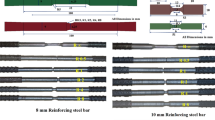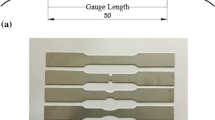Abstract
This paper is concerned with the empirical hardening equation of steel sheets for an auto-body at intermediate strain rates with the variation of temperature. In order to identify the temperature dependence of the strain-rate sensitivity of steel sheets such as SPRC35R, SPRC45E and TRIP60, uniaxial tensile tests have been performed with the variation of the strain rate from 0.001/sec to 200/sec and the environmental temperature from −40°C to 200°C. The thermo-mechanical response at the quasi-static state is obtained from static tensile tests and that at the intermediate strain rate is obtained from high speed tensile tests. The effects of both the strain rate and the temperature on the flow stress and the fracture elongation are investigated with the experimental data. Experimental results provide the variation of the strain-rate sensitivity with respect to the temperature. They also show that as the strain rate increases, the variation of flow stress becomes sensitive to the temperature. A phenomenological constitutive model is newly proposed by modifying the well-known Khan-Huang-Liang model. Based on the experimental data, both the strain rate and the temperature dependent sensitivity of the flow stress are considered in the proposed model by coupling the strain, the strain rate and the temperature. In order to verify the accuracy of the proposed model quantitatively, the standard error between the experimental data and the fitted one is compared with other empirical constitutive models such as the Johnson-Cook and the Khan-Huang-Liang models. The comparison demonstrates that the model proposed gives relatively accurate description of the experimental data at the various strain rates and temperatures.
Similar content being viewed by others
References
Abed, F. H. and Voyiadjis, G. Z. (2005). Plastic deformation modeling of AL-6XN stainless steel at low and high strain rates and temperatures using a combination of bcc and fcc mechanism of metals. Int. J. Plasticity, 21, 1618–1639.
Campbell, J. D. and Ferguson, W. G. (1970). The temperature and strain-rate dependence of the shear strength of mild steel. Phil. Mag., 21, 63–82.
Costin, L. S., Crisman, E. E., Hawley, R. H. and Duffy, J. (1979). On the localization of plastic flow in mild steel tubes under dynamic torsional loading. In Mechanical Properties at High Rates of Strain, Edn J. Harding, Inst. Phys. Conf. Ser. No. 47, 90–100.
Cottrell, A. H. (1953). Dislocations and Plastic Flow in Crystals. Clarendon. Oxford.
Cowper, G. R. and Symonds, P. S. (1957). Strain hardening and strain-rate effects in the impact loading of cantilever beams. Brown University Division of Applied Mathematics. Report No. 28.
Eleiche, A. M. (1981). Strain rate history and temperature effects on the torsional-shear behavior of a mild steel. Exp. Mech., 21, 285–294.
Follansbee, P. S. and Kocks, U. F. (1988). A constitutive description of the deformation of copper based on the use of the mechanical threshold stress as an internal state variable. Acta Metall., 36, 81–93.
Gilat, A. and Wu, X. (1997). Plastic deformation of 1020 steel over a wide range of strain rates and temperatures. Int. J. Plasticity, 13, 611–632.
Hoge, K. J. and Mukherjee, A. K. (1977). Temperature and strain rate dependence of the flow stress of tantalum. J. Mater. Sci. 12,8, 1666–1672.
Huh, H. and Kang, W. J. (2002). Crash-worthiness assessment of thin-walled structures with the highstrength steel sheet. Int. J. Vehicle Des., 30, 1–21.
Huh, H., Kang, W. J. and Han, S. S. (2002). A tension split Hopkinson bar for investigating the dynamic behavior of sheet metals. Exp. Mech., 42, 8–17.
Huh, H., Lim, J. H., Song, J. H., Lee, K. S., Lee, Y. W. and Han, S. S. (2003). Crashworthiness assessment of side impact of an auto-body with 60TRIP steel for side members. Int. J. Automotive Technology 4,3, 149–156.
Huh, H., Kim, S. B., Song, J. H. and Lim, J. H. (2008). Dynamic tensile characteristics of TRIP-type and DPtype steel sheets for an auto-body. Int. J. Mech. Sci., 50, 918–931.
Huh, H., Lim, J. H. and Park, S. H. (2009). High speed tensile test of steel sheets for the stress-strain curve at the intermediate strain rate. Int. J. Automotive Technology 10,2, 195–204.
Ishikawa, K. and Tanimura, S. (1992). Strain rate sensitivity of flow stress at low temperatures in 304N stainless steel. Int. J. Plasticity, 8, 947–958.
Johnson, G. R. and Cook, W. H. (1983). A constitutive model and data for metals subjected to large strain, high strain rates and high temperatures. Proc. 7th Int. Symp. Ballistics, The Hague, The Netherlands, 541–547.
Kang, W. J., Cho, S. S., Huh, H. and Chung, D. T. (1999). Modified Johnson-Cook model for vehicle body crashworthiness simulation. Int. J. Vehicle Des., 21, 424–435.
Khan, A. S. and Liang, R. (1999). Behaviors of three BCC metal over a wide range of strain rates and temperatures: Experiments and modeling. Int. J. Plasticity, 15, 1089–1109.
Khan, A. S. and Liang, R. (2000). Behaviors of three BCC metals during non-proportional multi-axial loadings: Experiments and modeling. Int. J. Plasticity, 16, 1443–1458.
Khan, A. S. and Huang, S. (1992). Experimental and theoretical study of mechanical behavior of 1100 aluminum in the strain rate range 10−5–104 s−1. Int. J. Plasticity, 8, 397–424.
Khan, A. S., Suh, Y. S. and Kazmi, R. (2004). Quasi-static and dynamic loading responses and constitutive modeling of titanium alloys. Int. J. Plasticity, 20, 2233–2248.
Khan, A. S. and Zhang, H. (2000). Mechanically alloyed nanocrystalline iron and copper mixture: Behavior and constitutive modeling over a wide range of strain rates. Int. J. Plasticity, 16, 1477–1492.
Kim, J. S., Huh, H., Lee, K. W., Ha, D. Y., Yeo, T. J. and Park, S. J. (2006). Evaluation of dynamic tensile characteristics of polypropylene with temperature variation. Int. J. Automotive Technology 7,5, 571–577.
Kim, K. P. and Huh, H. (2006). Dynamic limit analysis formulation for impact simulation of structural members. Int. J. Solids Struct., 43, 6488–6501.
Klepaczko, J. and Duffy, J. (1982). Strain rate history effects in body-centered-cubic metals. In Mechanical Testing for Deformation Model Development, Edn. R. W. Rhode and J. C. Swearengen, ASTM STP765, 251–268.
Kolsky, H. (1949). Stress Wave in Solids. Dover. New York.
Lee, W.-S. and Liu, C.-Y. (2006). The effects of temperature and strain rate on the dynamic flow behavior of different steels. Mat. Sci. Eng. A, 426, 101–113.
Li, C. C. and Leslie, W. C. (1978). Effect of dynamic strain aging on the subsequent mechanical properties of carbon steels. Metall. Trans. A, 9, 1765–1775.
Liang, R. and Khan, A. S. (1999). A critical review of experimental results and constitutive models for BCC and FCC metals over a wide range of strain rates and temperatures. Int. J. Plasticity, 15, 963–980.
Mahadevan, K., McCoy, R., Schell, B. and Fekete, J. (1998). Strain-rate characterization of automotive steel and the effect of strain-rate in component crash analysis. SAE Paper No. 982392.
McCormick, P. G. (1978). Strain rate sensitivity prior to the onset of serrated yielding in a pressurized low carbon steel. Scripta Metall., 12, 197–208.
Meyers, A. (1994). Dynamic Behavior of Materials. John Wiley & Sons. New York.
Miura, K., Takagi, S., Obara, T. and Tanimura, S. (1996). Dynamic deformation behavior of steel sheet for automobile. SAE Paper No. 960019.
Nemat-Nasser, S. and Guo, W.-G. (2001). Thermomechanical response of AL-6XN stainless steel over a wide range of strain rates and temperatures. J. Mech. Phys. Solids, 35, 1823–1846.
Nemat-Nasser, S. and Guo, W.-G. (2003). Thermomechanical response of DH-36 structural steel over a wide range of strain rates and temperatures. Mech. Mater., 35, 1023–1047.
Nemat-Nasser, S., Guo, W. G. and Kihl, D. P. (2001). Thermomechanical response of AL-6XN stainless steel over a wide range of strain rates and temperatures. J. Mech. Phys. Solids, 49, 1823–1846.
Nemat-Nasser, S. and Isaacs, J. B. (1996). Direct measurement of isothermal flow stress of metals at elevated temperatures and high strain rates with application to Ta and Ta-W alloys. Acta Mater., 45, 907–919.
Porsche Engineering Service Inc. (2001). ULSAB-AVC Engineering Report.
Robert, A. A. (1983). Thermal gradients, strain rate and ductility in sheet steel tensile specimens. Metall. Trans. A, 16, 37–43.
Robinson, J. M. and Shaw, M. P. (1994). Microstructural and mechanical influences on dynamic strain aging phenomena. Int. Mater. Rev., 39, 113–122.
Shi, N. F. and Meuleman, D. J. (1992). Strain rate sensitivity of automotive steels. SAE Paper No. 922045.
Song, J. H., Huh, H., Kim, H. G. and Park, S. H. (2006). Evaluation of the finite element modeling of a spot welded region for crash analysis. Int. J. Automotive Technology 7,3, 329–336.
Stevenson, R. (1982). Inferring microscopic deformation behavior from the form of constitutive equation for lowcarbon steel and 5182-0 aluminum. Edn R. W. Rhode and J. C. Swearengen, ASTM STP765, 366–381.
Tateno, H., Hishida, Y. and Shibata, K. (1998). New materials technology for achieving both crashworthiness and weight reduction using energy-absorbing steel with higher strain-rate sensitivity. SAE Paper No. 980953.
Uenishi, A. and Teodosiu, C. (2004). Constitutive modeling of the high strain rate behavior of interstitialfree steel. Int. J. Plasticity, 20, 915–936.
Yasuki, T. (2000). An investigation on vehicle crash analysis accuracy. Proc. EUROPAM 2000, Nantes, France, 1–5.
Zener, C. and Holloman, J. H. (1944). Effect of strain rate upon plastic flow of steel. J. Appl. Phys., 15, 22–32.
Zerilli, F. J. and Armstrong, R. W. (1987). Dislocationmechanics-based constitutive relations for material dynamics calculations. J. Appl. Phys., 61, 1816–1825.
Zukas, J. A., Nicholas, T., Swift, H. F., Greszczuk, L. B. and Curran, D. R. (1982). Impact Dynamics. John Wiley & Sons. New York.
Author information
Authors and Affiliations
Corresponding author
Rights and permissions
About this article
Cite this article
Huh, H., Lee, H.J. & Song, J.H. Dynamic hardening equation of the auto-body steel sheet with the variation of temperature. Int.J Automot. Technol. 13, 43–60 (2012). https://doi.org/10.1007/s12239-012-0005-8
Received:
Revised:
Published:
Issue Date:
DOI: https://doi.org/10.1007/s12239-012-0005-8




